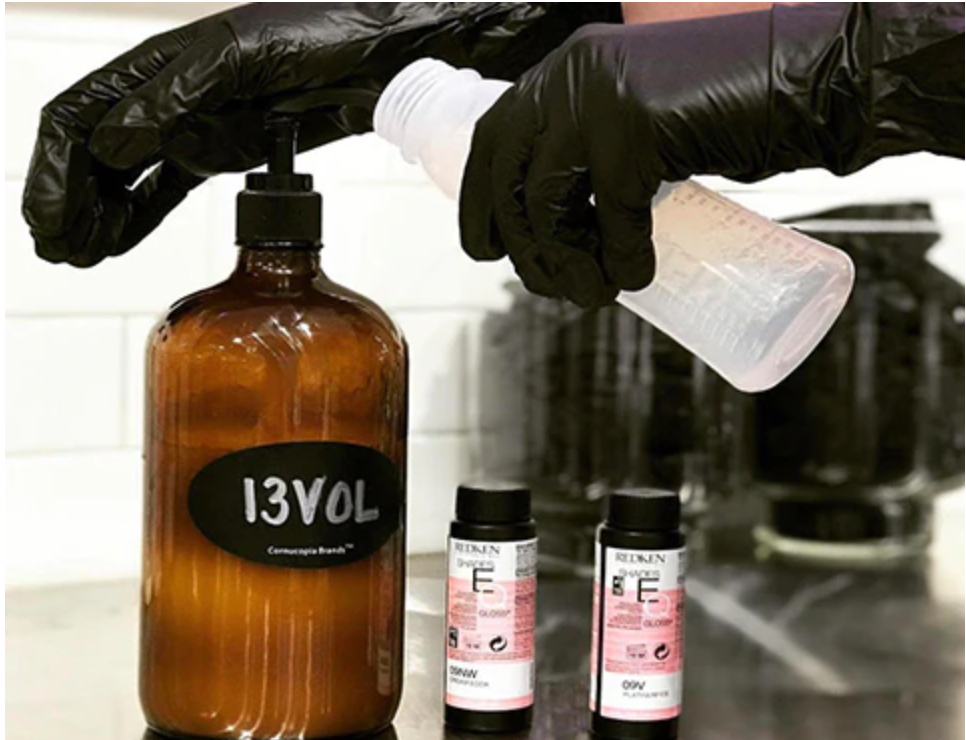
13 VOLUME DEVELOPER: EVERYTHING YOU NEED TO KNOW

The benefit of raising your developer has many variables, but understanding when and why to do this is important before actually attempting it.
In many cosmetology schools we were taught that the lower the developer the more deposit is achieved. While this can be true for depth deposit (level) it is not true for tonal deposit. In fact, the higher the developer the more tonal deposit occurs. This means when the developer is higher it can actually seem brighter or have a more intense pigment.
How Does Hair Developer Work?
Developer is the gas to get you where you’re going. The higher the developer, the more oxygen is brought to the color. So essentially when you use a higher developer in lightening services, it will burn out quicker than a lower one. Higher developers have a heavy punch in the beginning and then lose a lot of their power. Lower developers will lift slower and lift more evenly for longer.
The majority of all developers are the same: a mixture of peroxide and different conditioners. You can intermix them as needed for the most part with a few exceptions. Knowing your color line is so important before you make the choice to step out of the box.
How Color Line Affects Your Choice Of Developer
Knowing your color line is so important before you make the choice to step out of the box, because it can impact your final results.

When glossing and changing the developer you must be sure of 3 things:
1. ARE YOU USING A COLOR LINE THAT DOES NOT HAVE LIFTING ABILITY?
Alkalinity is what causes lift and if we look at developer, it is always acidic. So, its safe to say the lift is in the tube of color. It is important to know how your color line works before attempting to raise the volume when glossing. There are many demi-permanent lines that do still have lifting ability.
2. THE HAIR DOES NOT HAVE A SIGNIFICANT AMOUNT OF MINERAL BUILD.
This can cause a chemical reaction and appear to shift the root. Hair that has mineral build up will seem very greasy at the root and the ends will be dry and brittle. It will have little movement and lay more flat with no bounce. Your guest may say things like, “I wash my hair every day and it still feels greasy”. This can be for many reasons, but one of the major ones is mineral build up. This can happen even when people do not have well water, so do not rely solely on that information.
3. DOES THE CLIENT HAVE SUPER FINE HAIR ABOVE A LEVEL 8?
Raising the developer in this situation could appear as a root shift, but in actuality it is exposed melanin (which is warm), so it looks as if there is a shift. There are very few people who actually have a natural level above an 8, but it’s good to be aware of.
Raising Your Developer
Once you are familiar with how your gloss processes and the above 3 things checked out ok, you are in good shape to try raising that developer!
What does it do?
Raising the developer intensifies the tone of a gloss without having to drop a level. Most times, when we need to knock out more warmth or need a brighter warmth we would drop the level to get more pigment. When you raise just the developer it keeps things extra bright and that tone pops even more. This is not to be confused with glossing at a higher level than the actual lift. Always make sure you are at least glossing on level.
Keep in mind this is a subtle change in developer. Glossing with developer above a volume 15 is not necessary. This would cause too quick of a deposit and can be aggressive on freshly lightened hair. Developer in itself can still be damaging. Acidity (like lemon juice) will cause issues on fragile hair.
Raising the developer is great for just about any situation except when looking to keep things deeper or when trying to erase any sort of lines. Techniques like melting, lowlighting or smudging would require keeping that developer as low as possible.

A favorite combination? Redken Shades EQ with Wella Color Touch 13 volume.
As always, this is personal creative choice, testing and experience. Please do not try this until you are comfortable with the reasoning of why you are choosing to do it and have a great understanding of formulation and your specific color line.
Sign up for THE CONFIDENCE BEHIND FORMULATION course to go more in depth about everything color theory, formulation, developer choice, lightener choice and technique, formulating for tone and color corrections!
